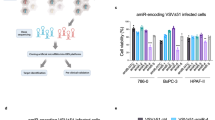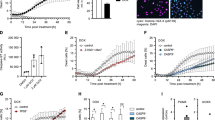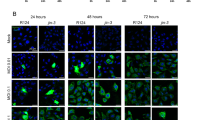Abstract
We have previously shown that adenoviral-mediated interferon α (Ad-IFNα) treatment is highly cytotoxic to tumor cells which are resistant to the IFNα protein. We now report that autophagy is produced after Ad-IFNα treatment of either IFN resistant bladder cancer cells (UC9 and KU7) or the normal urothelial cell line (TERT-NHUC). After Ad-IFNα infection autophagosomes, an early stage of autophagy, were seen in cancer cells whereas autophagolysosomes, a later stage of autophagy, were observed mostly in normal cells by electron microscopy. Conditioned medium from either normal or bladder cancer cells obtained after Ad-IFNα infection, however, produced no autophagy when placed on the bladder cancer cells, although again marked cytotoxicity was observed. This indicated that the autophagy seen was related to the direct effect of Ad-IFNα transfection and expression rather than to the bystander factors produced. In addition, autophagic changes were seen using LysoTracker Red DND-99 in both normal and cancer cells. We also documented that Ad-IFNα treatment produces the autophagic protein form, light chain 3 (LC3)-II, in cancer cells but not normal cells, which in turn was inhibited by the autophagic inhibitor, 3-methyladenine (3-MA). This inhibition of autophagy resulted in a significant increase in apoptotic cell death as measured by the sub-G1 population. We hypothesize that the autophagy seen in normal urothelial cells is a protective response and is allowed to be completed, providing a survival mechanism after Ad-IFN treatment, whereas the autophagy produced in IFN resistant cancer cells is not allowed to be completed and is insufficient to significantly suppress cytotoxicity.
This is a preview of subscription content, access via your institution
Access options
Subscribe to this journal
Receive 12 print issues and online access
$259.00 per year
only $21.58 per issue
Buy this article
- Purchase on Springer Link
- Instant access to full article PDF
Prices may be subject to local taxes which are calculated during checkout





Similar content being viewed by others
References
Benedict WF, Tao Z, Kim CS, Zhang X, Zhou JH, Adam L et al. Intravesical Ad-IFNα causes marked regression of human bladder cancer growing orthotopically in nude mice and overcomes resistance to IFNα protein. Mol Ther 2004; 10: 525–532.
Zhang X-Q, Yang Z, Dong L, Papageorgiou A, McConkey D, Benedict WF . Adenoviral-mediated interferon α overcomes resistance to the interferon protein in various cancer types and has marked bystander effects. Cancer Gene Ther 2007; 14: 241–250.
Zhang X-Q, Dong L, Chapman E, Benedict WF . Conditioned medium from Ad-IFNα infected bladder cancer and normal urothelial cells is cytotoxic to cancer cells but not normal cells: further evidence for a strong bystander effect. Cancer Gene Ther 2008; 15: 817–822.
Fisher MB, Zhang XQ, McConkey DJ, Benedict WF . Measuring soluble forms of extracellular cytokeratin 18 identifies both apoptotic and necrotic mechanisms of cell death produced by adenoviral-mediated interferon alpha: possible use as a surrogate marker. Cancer Gene Ther 2009; 16: 567–572.
Mizushima N, Yoshimori T . How to interpret LC3 immunoblotting. Autophagy 2007; 3: 542–545.
Benedict WF, Fisher MB, Cutler DL, Alice A, Young S, Yang Z et al. Results of a Phase 1 trial with intravesical Ad-IFN-α/Syn3 for superficial bladder cancer including putative marker studies (abstract). In: Proceedings of the 100th Annual Meeting of the American Association for Cancer Research 2009. Abstract #1449. American Association for Cancer Research: Philadelphia, PA.
Acknowledgements
This study was supported by a GU SPORE in Bladder Cancer (P50 CA91846) Project 5 to WFB and Institutional Core Grant #CA166772.
Author information
Authors and Affiliations
Corresponding author
Ethics declarations
Competing interests
The authors declare no conflict of interest.
Rights and permissions
About this article
Cite this article
Zhang, XQ., Dunner, K. & Benedict, W. Autophagy is induced by adenoviral-mediated interferon α treatment in interferon resistant bladder cancer and normal urothelial cells as a cell death protective mechanism but not by the bystander factors produced. Cancer Gene Ther 17, 579–584 (2010). https://doi.org/10.1038/cgt.2010.14
Received:
Accepted:
Published:
Issue Date:
DOI: https://doi.org/10.1038/cgt.2010.14
Keywords
This article is cited by
-
Eicosapentaenoic acid attenuated oxidative stress-induced cardiomyoblast apoptosis by activating adaptive autophagy
European Journal of Nutrition (2014)
-
Autophagic activity in the mouse urinary bladder urothelium as a response to starvation
Protoplasma (2013)
-
Direct cytotoxicity produced by adenoviral-mediated interferon α gene transfer in interferon-resistant cancer cells involves ER stress and caspase 4 activation
Cancer Gene Therapy (2011)
-
Direct gene transfer of adenoviral-mediated interferon α into human bladder cancer cells but not the bystander factors produced induces endoplasmic reticulum stress-related cytotoxicity
Cancer Gene Therapy (2011)



